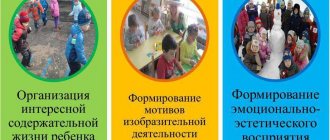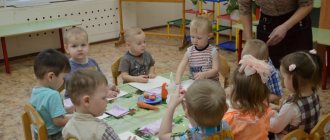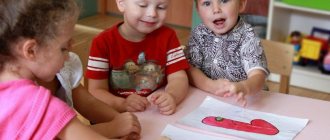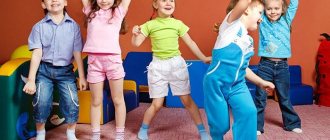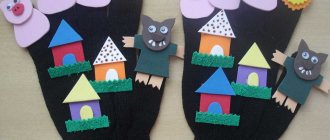Preparing the teacher for classes
Seminar for preschool teachers
Topic: Organization of classes in preschool educational institutions. Types of activities.
Goal: to systematize teachers’ knowledge about the structure of classes, their classification and features, to improve the professional level of teachers and creative activity
Progress of the lesson:
- The concept of “Occupation” - What is an occupation?
A lesson is a form of organizing teaching in kindergarten.
- Structure of the lesson - The lesson includes three stages: organizing the children, the main part of the lesson and the end of the lesson.
Organization of children:
- Checking the readiness of children for the lesson (appearance, correct seating, concentration of attention)
- Creating interest in the lesson (techniques that contain entertainment, surprise, mystery)
Main part of the lesson:
- Organization of children's attention
- Explanation of the material and demonstration of the method of action or setting a learning task and joint solution (3-5 min)
- Consolidation of knowledge and skills (repetition and joint exercises, independent work with didactic material)
End of class:
- Summing up (analysis together with the children of completed work, comparing the work with didactic tasks, assessing the children’s participation in the lesson, reporting what they will do next time)
- Switching children to another activity
- ^ Classification of occupations
| Basis of classification | Name |
| 1. Didactic task |
|
| 2. Content of knowledge |
|
| 3. Form of organization |
|
— Each of these types of classes will differ in the structure of the main part.
(Review and discussion of the table “Comparative analysis of classes”
)
The difference between a comprehensive and integrated lesson
A complex is an integrity formed from individual parts (arts, types of children's activities). Integrated classes are typically scheduled once a quarter in lieu of music or art classes. The complex lesson is based on material familiar to children. In this lesson, the tasks of each type of activity are solved.
For example: before drawing a festive city street, children sing a song about the holiday and read poetry.
Integrated classes presuppose a deeper form of interconnection and interpenetration of different contents of children’s upbringing and education. In integration, one type of activity acts as a core activity, while others help to achieve a broader and deeper understanding. An integrated lesson is aimed at learning new material. The lesson is planned on a common topic for several subjects and can be taught by several teachers. Integration of the content of educational material occurs around a specific topic.
For example: The lesson “Fairytale bird - swan” included the following methodological techniques:
- A story about the lifestyle and characteristics inherent in these birds
- Conversation: human behavior towards the animal world
- Discussion of the image of a swan from the fairy tales “Wild Swans”, “The Tale of Tsar Saltan”, “The Ugly Duckling”
- Listening to a fragment from Tchaikovsky’s ballet “Swan Lake”, Saint-Saens’ “The Swan”
- Completing a creative task: show how a swan moves to music.
- Examination of paintings by Rylov “In the Blue Space”, Vrubel “The Swan Princess”
- Drawing of flying swans.
This lesson combines tasks in the sections of the child and the world around him, speech development and literary reading, music, and visual arts. And the goal of all these tasks is to form in children an idea of the fairytale bird - swans.
Practical task
- Teachers receive cards with a brief description of the activities ( Appendix 2
). It is necessary to determine what type of activities they belong to, what types of activities they combine. - Determine what type of open classes conducted by teachers are.
Preparing the teacher for classes
Preparing a teacher for classes consists of three stages: planning classes, preparing equipment, preparing children for classes.
Lesson planning:
- Select program content, outline methods and techniques, think through the course of the lesson in detail
- Make a plan - a summary, which includes:
-Program content (educational objectives) -equipment -preliminary work with children (if necessary) -GCD logic and methodological techniques
- It is necessary to plan not just one lesson, but a system, gradually complicating and consolidating the material. We use methodological literature, but do not mechanically rewrite it, but use it taking into account the characteristics of children.
Equipment preparation:
- On the eve of the lesson, select the equipment, check whether it is in working order, whether there is enough teaching material, etc.
- Some activities need to be prepared in advance (for example, if you need to show a sprouted seed of a plant, it needs to be germinated in advance)
- When conducting an excursion, the teacher must go to the site in advance, highlight objects for observation, think about how the children will be accommodated, and choose the shortest and safest route.
Preparing children for classes
- Create interest in the upcoming work
- Warn children about the start of the lesson in advance (10 minutes in advance) so that the children have time to finish their games and get ready for the lesson
- Organize the work of those on duty in preparation for the lesson
Summing up
Practical advice for educators on conducting classes on the Federal State Educational Standard before
Kristina Vershinina
Practical advice for educators on conducting classes on the Federal State Educational Standard before
1. Think over the organization of children in the classroom (alternating different types of children’s activities: sitting, standing, on the carpet, in groups, in pairs, etc.)
2. High-quality preparation of visual materials for the lesson (accessibility to every child, modernity, quality and size of illustrations, multimedia presentations can be shown)
3. Compliance with the structure of the lesson :
— Introductory part (creating motivation and “don’t forget”
about her throughout
the lesson . For example, if Dunno came, then throughout the lesson he “participates”
in activities with children, at the end
of the lesson you can sum up the results on behalf of the character)
-Also in the first part of the lesson it is necessary to create a problem situation (or a problem-search situation)
for children, the solution of which they will find throughout the event. This technique allows preschoolers not to lose interest, develops mental activity, and teaches children to interact in a team or in pairs.
- During the main part, the teacher can use various management techniques: visual, practical and verbal , allowing him to solve the program tasks of the lesson and the problem-search situations posed.
— After each type of children’s activity, the teacher needs to conduct an analysis of the children’s activities (either on his own behalf, or on behalf of the character or with the help of other children)
is a requirement
In cases where something is not working out for children, the teacher can use a technique such as pedagogical support. For example, the teacher says : “I really liked how Seryozha, Marina and Lena made the traffic light, but Maxim and Oleg’s parts came off, but I think that next time they will definitely try and do everything well.”
Throughout the entire lesson (especially in older preschool age groups)
The teacher must monitor and encourage children to engage in speech activity with the help of questions.
Therefore, questions for children must be thought out in advance; they must be exploratory or problematic in nature; strive to ensure that children answer with a “complete answer”
.
You also need to control your own speech and construct speech phrases in the third person. For example, move away from the expression: “I want to invite you on a trip.”
- this is not correct, because the teacher seems to be
“imposing”
the upcoming activity. It would be more correct to address the children in this way:
“Let’s go on a trip.”
-Also, in accordance with new educational standards, the teacher can use pedagogical technologies: problem-based learning, research activities, project activities, health-saving technologies and more. (Depending on their type of children's activity and on the assigned tasks in the lesson ) For example, in a lesson on cognitive development in the second junior group “Visiting the Cockerel”,
the teacher can conduct articulatory gymnastics to develop breathing, etc. The
final part of the lesson should be organized like this in such a way that the solution to the problem and search situation can be traced (so that children see the solution to the task: either a verbal conclusion, or the result of productive or research activity, etc.).
-It is also necessary to summarize the entire lesson : evaluate the children’s activities (you can use pedagogical support, analyze each other’s children, themselves, praise the children on behalf of the character, etc.). The main thing is not to forget about motivation (which is set at the beginning of the lesson, see point above)
.
4. A distinctive feature of classes in the Federal State Educational Standard for Preschool Education is the active speech activity of children (questions to children should be problem-solving in nature, and also carefully thought out.
For example, children need to help the Hen find the chickens. The teacher might ask: “Do you want to help the Hen find the chickens? How can this be done?
That is, the question is problematic in nature and forces children to think through answer options: call the chickens, go after them, etc.
5. The teacher is simply obliged to provide children with “freedom of choice”
upcoming activities and, at the same time, with your skill to captivate children with you.
For example, the teacher of the first junior group during an educational lesson told the children the fairy tale “Kolobok”
, and then offered motivation for the upcoming activity
(collective application of the character Kolobok)
“Guys, Kolobok ran away from his grandparents, they are crying bitterly. How can we help our grandparents? Then it offers possible answers: maybe we should draw a Kolobok and give it to our grandparents? Thus, she captivated the children, organized motivation for drawing, got them interested, and also solved the educational task : to make the children want to help their grandparents in finding Kolobok.
Thus, it should be concluded that currently the requirements for conducting classes have changed , since there are pedagogical technologies that must be used in the implementation of the Federal State Educational Standard for Education.

